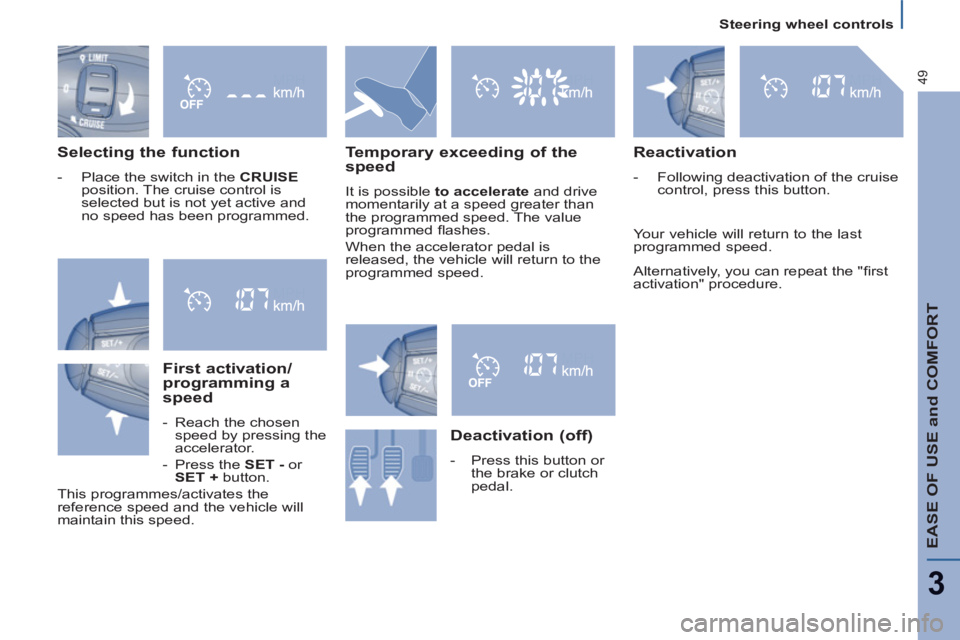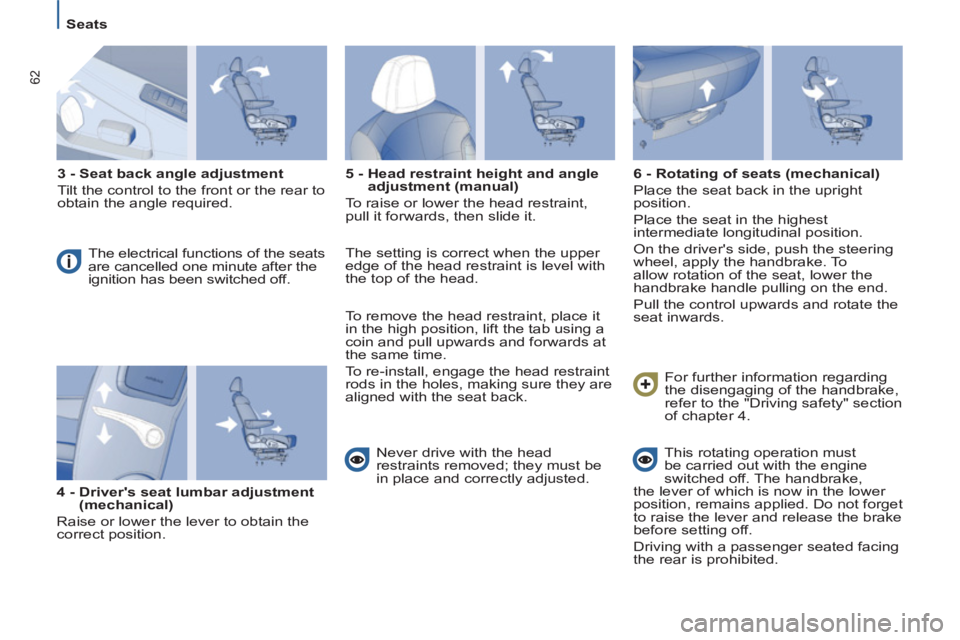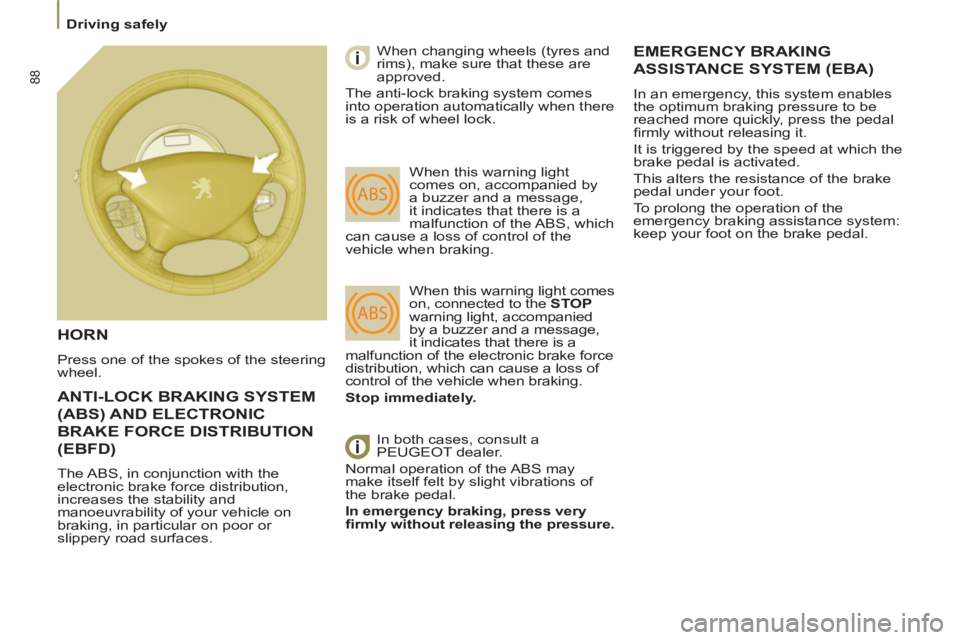2013 Peugeot 807 brake
[x] Cancel search: brakePage 42 of 234

Gearboxes and steering wheel
40
Good practice
Never select position N
when the
vehicle is moving.
Never select positions P
or R
unless
the vehicle is stationary.
Never change between positions to
optimise braking on a slippery surface.
There is a risk of damage to the
gearbox:
- if you press the accelerator and
brake pedals at the same time,
- if you force the lever from
position P
to another position in
the event of a battery failure.
When the engine is at idle, brakes
not applied, if position R
, D
or M
is
selected the vehicle moves even
without the accelerator being pressed.
For this reason, do not leave children
unsupervised inside the vehicle,
with the engine running
.
Operating abnormality
Any operating abnormality is indicated
by an audible signal, accompanied by
the message "Automatic gear fault"
on the display and fl ashing of the Snow
snowfl ake on the instrument panel.
In this situation the gearbox operates in
downgrade mode (locked in 3rd gear).
You may feel a substantial knock when
changing from P
to R
and from N
to R
(this will not cause any damage to the
gearbox).
Do not exceed 60 mph (100 km/h),
keeping within the limit of local speed
restrictions.
Contact a PEUGEOT dealer as soon
as possible.
You can return to the automatic
programme at any time.
- Press button �7 again to switch off
the programme you are in.
Snow programme
In addition to the automatic
programme, there is a special
Snow programme.
This improves starting
and drive when traction is
poor. The snowfl ake appears on the
instrument panel display.
- Press button �7 once the
vehicle has been started
and position D
selected.
The gearbox adapts to driving
on slippery roads.
Page 44 of 234

42
Starting and stopping
STARTING AND STOPPING
STOP position: steering lock.
The ignition is off.
Good practice when starting
Handbrake
If your vehicle is fi tted with a
version with a rotating front seat,
the handbrake can be disengaged.
Pulling the handbrake to immobilise
the vehicle then lowering the lever
does not release the brake, it permits
rotation of the driver’s seat.
Pull the button placed at the end of the
handbrake forwards.
The handbrake lever lowers.
You can now rotate the seat.
To return to normal operation, pull the
lever up until it clicks.
If the handbrake is on or has
not been released fully, this is
indicated by:
- a warning light which comes
on on the instrument panel,
- an audible signal,
- a message on the display.
Key
Take care not to place the key in
contact with grease, dust, rain or a
damp environment.
A heavy object attached to the key
(key ring, …) weighing down on the
shaft of the key in the ignition switch
may cause a malfunction.
Running and accessories position.
Certain accessories can be used.
Starting position.
The starter is operated.
Diesel pre-heating warning
light
Turn the key to the Running
position.
In cold weather, wait for this warning
light to switch off then operate the
starter (Starting position) until the
engine starts.
If the temperature is high enough, the
warning light comes on for less than
one second, you can start without
waiting.
Good practice when stopping
Minimise engine and gearbox wear
When switching off the ignition, let the
engine run for a few seconds to allow
the turbocharger to return to idle.
Do not press the accelerator when
switching off the ignition.
There is no need to engage a gear
after parking the vehicle.
Page 51 of 234

Steering wheel controls
EASE OF USE and COMFORT
3
49
Selecting the function
- Place the switch in the CRUISE
position. The cruise control is
selected but is not yet active and
no speed has been programmed.
First activation/
programming a
speed
- Reach the chosen
speed by pressing the
accelerator.
- Press the SET -
or
SET +
button.
This programmes/activates the
reference speed and the vehicle will
maintain this speed.
Temporary exceeding of the
speed
It is possible to accelerate
and drive
momentarily at a speed greater than
the programmed speed. The value
programmed fl ashes.
When the accelerator pedal is
released, the vehicle will return to the
programmed speed.
Reactivation
- Following deactivation of the cruise
control, press this button.
Your vehicle will return to the last
programmed speed.
Alternatively, you can repeat the "fi rst
activation" procedure.
Deactivation (off)
- Press this button or
the brake or clutch
pedal.
Page 64 of 234

62
Seats
3 - Seat back angle adjustment
Tilt the control to the front or the rear to
obtain the angle required.
The electrical functions of the seats
are cancelled one minute after the
ignition has been switched off.
4 - Driver's seat lumbar adjustment
(mechanical)
Raise or lower the lever to obtain the
correct position.
5 - Head restraint height and angle
adjustment (manual)
To raise or lower the head restraint,
pull it forwards, then slide it.
Never drive with the head
restraints removed; they must be
in place and correctly adjusted.
6 - Rotating of seats (mechanical)
Place the seat back in the upright
position.
Place the seat in the highest
intermediate longitudinal position.
On the driver's side, push the steering
wheel, apply the handbrake. To
allow rotation of the seat, lower the
handbrake handle pulling on the end.
Pull the control upwards and rotate the
seat inwards.
This rotating operation must
be carried out with the engine
switched off. The handbrake,
the lever of which is now in the lower
position, remains applied. Do not forget
to raise the lever and release the brake
before setting off.
Driving with a passenger seated facing
the rear is prohibited. For further information regarding
the disengaging of the handbrake,
refer to the "Driving safety" section
of chapter 4. The setting is correct when the upper
edge of the head restraint is level with
the top of the head.
To remove the head restraint, place it
in the high position, lift the tab using a
coin and pull upwards and forwards at
the same time.
To re-install, engage the head restraint
rods in the holes, making sure they are
aligned with the seat back.
Page 88 of 234

86
Driving safely
HANDBRAKE
HAZARD WARNING LIGHTS
Press the button, the direction
indicators fl ash.
They can operate with the ignition off.
Automatic lighting of hazard
warning lights
Equipment conditioned according
to country: when braking in an
emergency, depending on the
deceleration, the hazard warning lights
come on automatically. They switch
off automatically the fi rst time you
accelerate.
It is also possible to switch them off by
pressing the button.
DRIVING SAFELY
Applying
When parking, pull the handbrake to
immobilize your vehicle.When parking
on a slope, direct your wheels towards
the pavement and pull the handbrake.
Releasing
Pull on the handle and press the button
to release the handbrake. Pull the button located at the end of the
handbrake forwards.
The handbrake lever lowers.
You can now pivot the seat.
To return to normal operation, pull the
lever upwards until a click is heard.
If the handbrake is still on or has
not been released properly, this is
indicated by:
Disengaging
If your vehicle is fi tted with a version
with a rotating front seat, apply the
handbrake. a warning light which comes
on on the instrument panel,
an audible signal,
a message on the display.
Page 90 of 234

88
Driving safely
ANTI-LOCK BRAKING SYSTEM
(ABS) AND ELECTRONIC
BRAKE FORCE DISTRIBUTION
(EBFD)
The ABS, in conjunction with the
electronic brake force distribution,
increases the stability and
manoeuvrability of your vehicle on
braking, in particular on poor or
slippery road surfaces.
HORN
Press one of the spokes of the steering
wheel. When changing wheels (tyres and
rims), make sure that these are
approved.
The anti-lock braking system comes
into operation automatically when there
is a risk of wheel lock.
When this warning light
comes on, accompanied by
a buzzer and a message,
it indicates that there is a
malfunction of the ABS, which
can cause a loss of control of the
vehicle when braking.
When this warning light comes
on, connected to the STOP
warning light, accompanied
by a buzzer and a message,
it indicates that there is a
malfunction of the electronic brake force
distribution, which can cause a loss of
control of the vehicle when braking.
Stop immediately.
In both cases, consult a
PEUGEOT dealer.
Normal operation of the ABS may
make itself felt by slight vibrations of
the brake pedal.
In emergency braking, press very
fi rmly without releasing the pressure.
EMERGENCY BRAKING
ASSISTANCE SYSTEM
(EBA)
In an emergency, this system enables
the optimum braking pressure to be
reached more quickly, press the pedal
fi rmly without releasing it.
It is triggered by the speed at which the
brake pedal is activated.
This alters the resistance of the brake
pedal under your foot.
To prolong the operation of the
emergency braking assistance system:
keep your foot on the brake pedal.
Page 91 of 234

SAFETY
89
Driving safely
4
TRACTION CONTROL (ASR)
AND DYNAMIC STABILITY
CONTROL
(ESP)
Activation of the ASR and ESP
systems
When the ignition is on, the ASR and
ESP systems are always active.
Disarming the ASR/ESP
systems
In certain conditions (vehicle stuck in
mud or snow, or on loose ground...), it
could prove useful to disarm the ASR
and ESP systems to make the wheels
spin and regain grip.
�)
Press the switch, situated under
the steering wheel on the left of the
fascia.
The indicator light comes on
accompanied by a message:
the ESP and ASR systems
no longer act on the engine
operation, but continue to act
on the brakes.
Operating check
The ASR/ESP systems offer
increased safety during normal
driving, but should not incite the
driver to take risks or to drive at high
speed.
The operation of these systems is
ensured if the recommendations
of the manufacturer regarding
the wheels (tyres and rims), the
braking components, the electronic
components and the fi tting and repair
procedures within the PEUGEOT
network are observed.
After an impact, have these systems
checked by a PEUGEOT dealer.
They engage again:
�)
automatically above 30 mph
(50 km/h),
�)
manually by pressing the switch
again.
Operation of the ASR and
ESP systems
The warning light fl ashes if
the ASR or ESP is activated.
These systems are linked and
complement the ABS.
The ASR system optimises drive to
prevent the wheels skidding, by acting
on the brakes of the drive wheels
and on the engine. It also allows the
directional stability of the vehicle to be
improved on acceleration.
If there is a variation between the
trajectory followed by the vehicle and
that required by the driver, the ESP
system automatically acts on the
engine and the brake of one or more
wheels, in order to put the vehicle back
on course, within the limits of the laws
of physics. When a malfunction of the
systems occurs, the indicator
light comes on, accompanied
by an audible signal and a
message on the display.
Consult a PEUGEOT dealer to have
the system checked.
Page 92 of 234

90
Driving safely
TYRE UNDER-INFLATION
DETECTION
Sensors check the tyre pressure during
driving, and trigger a warning in the
event of a malfunction (speed greater
than approx.15 mph [25 km/h]) or
puncture.
An outline representing one or more
wheels fl ashing indicates the location
of the wheel or wheels concerned.
Flat tyre
The SERVICE warning light
comes on, accompanied
by the message "Tyre(s)
defl ated"
, an outline on the display,
and an audible signal.
Check the tyre pressure as soon as
possible. If the damaged tyre is temporarily
stored in the boot, it will again emit
this message to remind you of the
necessity of having it repaired. This will
prevent another warning of the same
type being displayed.
Sensor(s) not detected
The SERVICE warning light
comes on, accompanied
by the message "X tyre
pressure sensor(s) missing"
, an
outline on the display and an audible
signal.
Under-infl ation detection is absent
from one (or several) tyre(s). Consult a
PEUGEOT dealer to replace the faulty
sensor(s). This message is also displayed
when one of the tyres is away
from the vehicle (being repaired)
or when a wheel without a sensor is
fi tted.
All repairs and changing of
tyres on a wheel fi tted with this
system must be carried out by a
PEUGEOT dealer.
The tyre under-infl ation detection
system is a driving aid which does
not take the place of the vigilance or
the responsibility of the driver.
This system does not remove the
need to have the tyre pressure
checked regularly (including the spare
wheel), to ensure that the dynamic
performance of the vehicle remains at
its best and to avoid premature wear
of the tyres, in particular in the case
of arduous driving (heavy load, high
speed).
The system may temporarily be
disturbed by radio broadcasts on a
frequency close to it.
Puncture
The STOP warning light
comes on, accompanied
by the message
"Punctured tyre(s)"
, an outline on the
display and an audible signal.
Stop immediately, avoiding any sudden
movement of the steering wheel and
the brakes.
Change the damaged (punctured or
very defl ated) tyre, and have the tyre
pressure checked as soon as possible.
Refer to the "Changing a wheel"
section of chapter 7.